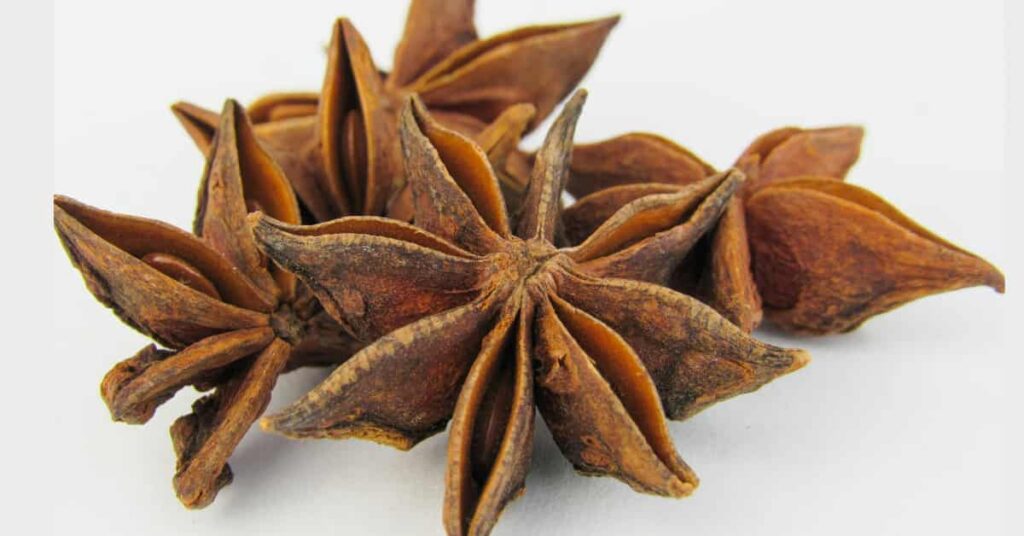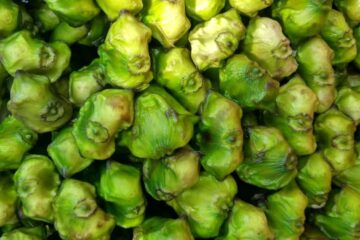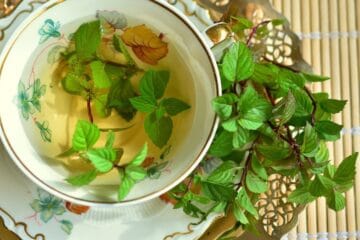Table of Contents
Introduction
Star Anise (Illicium verum), known in India as Chakri Phool, is arguably the most aesthetically pleasing and pharmacologically powerful spice in Asian cuisine. It is the dried, star-shaped fruit of an evergreen tree native to China and Vietnam, prized for its potent, licorice-like aroma and warm, sweet flavor, which comes from the essential oil compound anethole.
Further, its culinary role in garam masala, biryanis, and aromatic broths like Vietnamese phở, its true international significance lies in its high concentration of shikimic acid, a compound necessary for manufacturing the antiviral drug Tamiflu (oseltamivir). It creates the spice, an essential resource for combating viral infections like influenza. At the same time, its rich profile of antioxidants and antimicrobial agents continues to be studied for advantages ranging from improved digestion to potential defense against certain bacteria and fungi.

Star Anise
Star anise (Illicium verum) is an evergreen shrub or smallish tree native to Asia. It’s traditionally utilized as a spice in food and also as a medication.
Star anise seeds contain chemicals that might have antibacterial effects. One such chemical is shikimic acid, which is utilized to make oseltamivir (Tamiflu), a flu remedy. However, it’s not clear if star anise itself has antiviral effects.
Individuals utilize this for respiratory infections, colic in babies, stomach disorders, and other conditions, but no good scientific evidence supports these benefits.
In 2003, the US FDA cautioned consumers not to consume teas brewed from star anise due to reports of heavy side effects. Some star anise tea products have been infected with Japanese star anise (Illicium anisatum), a known toxin.
What does star anise taste like
It has a bold, distinct, and highly aromatic flavor profile characterized by a rich licorice or anise note.
Here is a sensory breakdown:
- Primary Taste: Intensely sweet and licorice-like. This flavor comes from the compound anethole, which is present in high concentrations and is the same compound found in anise seed and fennel.
- Aroma and Warmth: It carries a pronounced warm, spicy, and woody aroma reminiscent of a mix between cinnamon, clove, and fennel. This warm, earthy quality deepens when the spice is used in slow cooking.
- Intensity: The flavor is potent and stronger than anise seed or fennel. Because of its intensity, star anise must be used sparingly; if too much is added, it can easily overpower a dish and leave a slightly medicinal or bitter aftertaste.
- Culinary Role: Its complex profile allows it to bridge the gap between sweet and savory; it is essential in savory Chinese braised meats and Vietnamese phở, yet equally at home in sweet applications like mulled wine, pies, and Indian masala chai.

Star anise benefits
Star Anise (Chakri Phool) is a critically important spice renowned for its pharmaceutical potential and traditional healing uses. Its medicinal power is concentrated in key bioactive compounds, particularly shikimic acid and anethole.
Here are 13 health benefits attributed to it:
- Essential Antiviral Precursor: Its is the primary natural source of shikimic acid, the key precursor compound required for the pharmaceutical synthesis of Oseltamivir (Tamiflu), a leading medication used to treat and prevent influenza.
- Broad-Spectrum Antibacterial: Lab studies have shown that star anise extract can be effective against numerous drug-resistant pathogenic bacterial strains, including E. coli and Staphylococcus aureus.
- Potent Antifungal Defense: The compound anethole exhibits strong antifungal properties, inhibiting the growth of various pathogenic fungi, including yeasts like Candida albicans.
- Reduces Inflammation (Anti-Inflammatory): Compounds like anethole and quercetin help reduce inflammatory markers in your body, potentially relieving conditions like arthritis and general pain.
- High Antioxidant Capacity: It is rich in flavonoids and polyphenols that neutralize free radicals, mitigating oxidative stress and promoting cellular health and disease prevention.
- Aids Digestive Comfort: Traditionally used in Chinese and Indian medicine, star anise possesses carminative and antispasmodic properties that help relieve common digestive issues such as bloating, gas, indigestion, and nausea.
- Treats Respiratory Issues: It is a traditional remedy to alleviate respiratory tract infections, coughs, and bronchitis. It acts as an expectorant to help clear phlegm and congestion.
- Potential Blood Sugar Regulation: Animal research suggests that compounds like anethole may help regulate blood sugar levels by regulating carbohydrate metabolism and improving insulin function.
- Supports Liver Health: It’s antioxidants may protect the liver from chemical damage and oxidative stress, supporting overall liver function.
- May Support Heart Health: Preclinical models suggest that its antioxidant and anti-inflammatory effects can benefit cardiovascular health by regulating blood pressure (BP) and cholesterol levels.
- Anticancer Potential (Preclinical): Research in test tubes and animals indicates that star anise’s high antioxidant profile and specific compounds may possess anticancer properties, potentially by inhibiting tumor growth.
- Promotes Skin Health: Star anise’s antimicrobial and antioxidant properties can contribute to clearer skin by fighting acne-causing bacteria and reducing inflammation.
- Calming/Sedative Effects: Traditionally used to treat insomnia, the spice may have mild sedative properties that can help relieve anxiety and promote relaxation, contributing to better sleep quality.

Star anise benefits for females
This is highly valued in traditional medicine for its unique properties, which stem primarily from the compound anethole and particularly support a woman’s hormonal and reproductive health.
Here are the key benefits for females:
- Menstrual Comfort and Cramp Relief: It has antispasmodic properties, which help relax uterine muscles. Consuming star anise tea or using it in food may help ease the severity and frequency of menstrual cramps (dysmenorrhea).
- Supports Hormonal Balance (Phytoestrogenic): The compound anethole found in star anise acts as a phytoestrogen (a plant-based compound that weakly mimics estrogen). This activity is traditionally utilized to help regulate and balance estrogen levels, which are crucial during menstrual cycles and hormonal shifts.
- Eases Menopausal Symptoms: Due to its phytoestrogenic effect, star anise is studied for its ability to alleviate common menopausal symptoms, for example, hot flashes and mood swings, providing a natural option for hormonal transition support.
- Promotes Lactation (Galactagogue): In traditional practices, it is used to help increase the flow of breast milk in nursing mothers, though this benefit requires further scientific validation.
- Reduces Digestive Discomfort: It is a powerful carminative. It eases the bloating, gas, and digestive discomfort that often accompany hormonal shifts and menstruation.
- Antioxidant and Anti-Aging for Skin: The flavonoids and polyphenols in the spice fight cellular damage and inflammation, which translates to healthier skin and may help minimize the visible signs of aging.
- Antimicrobial Protection: Its potent antimicrobial compounds help maintain overall health, guarding against common infections that can impact reproductive wellness.

Star anise benefits for males
This is highly valued in traditional medicine for its warming and stimulating effects, which are believed to translate into several benefits for male health and vitality:
- Supports Male Fertility: It contains powerful antioxidants that may protect sperm cells from oxidative stress. This antioxidant protection is key to maintaining sperm quality, count, and progressive motility.
- Potential Testosterone Support: In traditional folk remedies, it is associated with naturally supporting and enhancing testosterone levels, which is the primary hormone driving libido, physical energy, and muscle vitality in men.
- Enhances General Stamina and Energy: As a stimulating spice, it contributes to overall well-being by improving metabolism and blood circulation, which helps fight fatigue and boosts physical and mental stamina.
- Aids Digestive Efficiency: Drinking star anise tea (or as a spice) aids in smooth digestion, ensuring better nutrient absorption and preventing issues like gas and bloating that can disrupt a man’s daily energy and focus.
- Relief from Stress and Anxiety: The spice contains compounds with mild calming properties (like Linalool). By helping to reduce anxiety and mental fatigue, star anise supports the emotional and mental state necessary for maintaining a healthy libido and intimate life.
- Respiratory Health Support: It contains shikimic acid (the precursor to the anti-flu drug Tamiflu) and expectorant compounds, making it a powerful natural remedy for clearing congestion and supporting respiratory health during cold and flu season.
- Anti-Inflammatory Defense: The spice’s potent anti-inflammatory compounds help reduce general inflammation throughout the body, contributing to overall physical comfort and performance.
Star Anise Plant
Here is a summary of its key characteristics:
- Classification: It is a tropical/subtropical evergreen tree that, when cultivated, typically grows between 15 and 25 feet tall.
- Fruit and Spice: The spice is the star-shaped, reddish-brown fruit of the tree, which is harvested just before it fully ripens and then dried. The fruit usually has six to eight boat-shaped segments, each containing a single glossy seed.
- Flavor Compound: The intense, liquorice-like flavor is primarily due to the essential oil compound anethole.
- Toxicity Warning: Crucially, the edible Illicium verum should never be confused with its highly toxic cousin, the Japanese Anise (Illicium anisatum), which contains the powerful neurotoxin anisatin. Since the two look nearly identical, sourcing star anise from reputable suppliers is essential.
- Cultivation: The tree thrives in warm, humid climates and is now grown commercially in India (particularly in the Northeast), China, and Vietnam.

Star anise tea
- Boil and Simmer: Take the water to a boil in a saucepan. Add the whole star anise pods (and other spices like cinnamon or ginger). Reduce the heat & let the mixture gently simmer for 5–10 minutes to extract the essential oils properly.
- Steep: Turn off the heat and let the tea steep for another 10 minutes to deepen the flavor and medicinal potency.
- Serve: Strain the tea into a mug, removing the solid spices. If desired, sweeten with honey or jaggery.
Key Benefits of Star Anise Tea
- Antiviral Support (Shikimic Acid): The tea extracts shikimic acid, a key compound used in the pharmaceutical production of the anti-influenza drug Tamiflu. While not a substitute for medication, the tea is a popular traditional remedy for fighting cold and flu symptoms.
- Aids Digestion: Star anise has carminative (gas-relieving) and antispasmodic properties. Drinking the warm tea after meals helps relax the gastrointestinal muscles, significantly relieving bloating, gas, and indigestion.
- Respiratory Relief (Expectorant): The aromatic steam and compounds in the tea act as an expectorant, helping to loosen mucus and clear congestion in the throat and chest, soothing coughs and bronchitis symptoms.
- Antioxidant and Anti-Inflammatory Boost: The tea is rich in powerful antioxidants (flavonoids and polyphenols) that boost immunity and fight inflammation throughout the body.
- Calming Effect: The essential oils in star anise are often used to reduce stress and tension, making the warm tea a soothing beverage to promote relaxation.
Caution: Always use genuine Chinese Star Anise (Illicium verum). Never confuse it with the highly toxic Japanese Star Anise (Illicium anisatum), which looks similar but is poisonous. Avoid drinking star anise tea if you are pregnant, breastfeeding, or administering it to infants without medical guidance.
Side effects of star anise
While Chinese Star Anise (Illicium verum) is generally considered safe when used as a food spice, its consumption carries significant risks, particularly as a strong tea or supplement, mainly due to potential toxicity and adulteration.
The side effects of star anise are severe and centered mainly around the confusion with a toxic cousin:
1. High Risk of Toxicity (The Contamination Danger)
The most severe risk comes from contamination with Japanese Star Anise (Illicium anisatum), which looks nearly identical but is highly poisonous.
- Neurotoxicity: Ingestion of the toxic species can cause severe neurological symptoms, particularly in infants and children. These neurotoxic effects include:
- Seizures and Convulsions.
- Hallucinations and altered consciousness.
- Irritability, severe lethargy, and spasticity.
2. Gastrointestinal Distress
- Severe Nausea and Vomiting: Gastrointestinal symptoms are common in cases of toxicity or when excessive amounts of the spice are consumed, especially when brewed as a concentrated tea.
- Abdominal Cramping and Diarrhea: This can occur due to high concentrations of specific compounds.
3. Dosage and Population Sensitivity
- Unsafe for Infants and Children: Due to the severe risk of neurotoxicity from contamination, star anise tea is widely considered unsafe for infants and children. Case reports have linked its use (often as a home remedy for colic) to seizures in babies.
- High Dose Toxicity: Even pure Chinese star anise (Illicium verum) contains naturally occurring neurotoxic compounds (veranisatins) that can cause adverse impact if consumed in excessive quantities or if the tea is boiled for too long, leading to a high concentration.
4. Drug Interactions and Allergies
- Blood Thinners: Star anise contains compounds that might slow blood clotting. Due to the higher risk of bleeding or bruising, it should be used with caution and ideally avoided by individuals taking anticoagulant medications (blood thinners).
- Hormone-Sensitive Conditions: Due to its mild phytoestrogenic activity (mimicking estrogen), star anise might interfere with hormone therapies or worsen hormone-sensitive conditions like breast cancer.
- Hypersensitivity: Allergic reactions, including skin rashes and swelling, are possible in sensitive individuals.
Safety Precaution: To minimize risk, always buy whole star anise from a reputable source and use it sparingly in food. Avoid star anise teas if the purity of the source cannot be guaranteed.
Conclusion
Star anise (Illicium verum) is an evergreen shrub or smallish tree native to Asia. It’s traditionally utilized as a spice in food and also as a medication.
Star anise seeds contain chemicals that might have antibacterial effects. One such chemical is shikimic acid, which is utilized to




